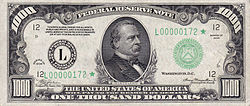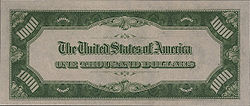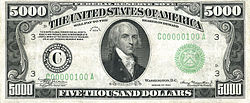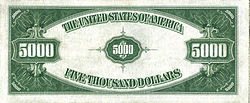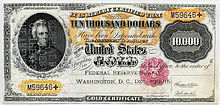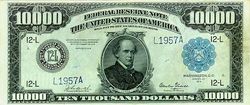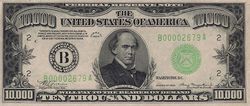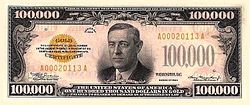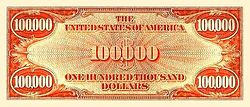- Large denominations of United States currency
-
The base currency of the United States is the U.S. dollar, and is printed on bills in denominations of $1, $2, $5, $10, $20, $50, and $100.
At one time, however, it also included five larger denominations. High-denomination currency was prevalent from the very beginning of U.S. Government issue (1861). $500, $1,000, $5,000, and $10,000 interest bearing notes were issued in 1861, and $5,000 and $10,000 United States Notes were released in 1878. There are many different designs and types of high-denomination notes.
The high-denomination bills were issued in a small size in 1929, along with the $1 through $100 denominations. The designs were as follows:
- $500: William McKinley
- $1,000: Grover Cleveland
- $5,000: James Madison
- $10,000: Salmon P. Chase
- $100,000: Woodrow Wilson
The reverse designs are abstract scrollwork with ornate denomination identifiers. All were printed in green, except for the Series of 1934 gold certificate, which were printed in orange on the reverse. These Series 1934 gold certificates (of denominations $100, $1,000, $10,000, and $100,000) were issued after the gold standard was repealed and gold was compulsorily confiscated by order of President Franklin Roosevelt on March 9, 1933 (see United States Executive Order 6102), and thus were used only for intra-government transactions and not issued to the public. Of these, the $100,000 is an odd bill in that it was printed only as this Series 1934 gold certificate. This series was discontinued in 1940. The other bills are printed in black and green as shown by the $10,000 example (pictured below).
Although they are still technically legal tender in the United States, high-denomination bills were last printed in 1945 and officially discontinued on July 14, 1969, by the Federal Reserve System. [1] The $5,000 and $10,000 effectively disappeared well before then. Of the $10,000 bills, 100 were preserved for many years by Benny Binion, the owner of Binion's Horseshoe casino in Las Vegas, Nevada, where they were displayed encased in acrylic. The display has since been dismantled and the bills sold to private collectors. Also, there is one large size, 1800's-era $1,000 bill in the Birdcage Theater in Tombstone, Arizona underneath the glass counter top.
The Federal Reserve began taking high-denomination bills out of circulation in 1969. As of May 30, 2009, there were only 336 known $10,000 bills in circulation; 342 remaining $5,000 bills; and 165,372 remaining $1,000 bills.[2] Due to their rarity, collectors will pay considerably more than the face value of the bills to acquire them.
For the most part, these bills were used by banks and the Federal Government for large financial transactions. This was especially true for gold certificates from 1865 to 1934. However, the introduction of the electronic money system has made large-scale cash transactions obsolete. When combined with concerns about counterfeiting and the use of cash in unlawful activities such as the illegal drug trade, it is unlikely that the U.S. government will re-issue large denomination currency in the near future, despite the amount of inflation that has occurred since 1969. According to the US Department of Treasury website, "The present denominations of our currency in production are $1, $2, $5, $10, $20, $50, and $100. Neither the Department of the Treasury nor the Federal Reserve System has any plans to change the denominations in use today."[3]
Contents
$500 bill
The $500 bill featured William McKinley on the obverse and the words "Five Hundred Dollars" on the reverse. It was released as a small-size Federal Reserve Note (sometimes nicknamed "watermelon notes" due to the design on the reverse) in 1928, 1934 and 1934A, and a small-size Gold Certificate in 1928.
1879 $500 bill
Series 1869 $500 Legal tender note with a vignette of Justice and John Quincy Adams1918 $500 bill
Series 1918 $500 bill, Obverse, with Chief Justice John MarshallSeries 1918 $500 bill, Reverse, depicting Hernando de Soto discovering the Mississippi River$1,000 bill
The $1000 bill featured Grover Cleveland on the obverse and the words "One Thousand Dollars" on the reverse. It was printed as a small-size Federal Reserve Note in 1928, 1934 and 1934A, and a small-size Gold Certificate in 1928 and 1934. As of May 30, 2009[update], there were 165,372 $1,000 bills in private hands.[2]
1918 $1000 bill
Series 1918 $1000 bill, Obverse, with Alexander Hamilton1934 $1000 bill
Series 1934 $1000 bill, Obverse, with Grover Cleveland$5,000 bill
The $5000 bill featured James Madison on the obverse. There is a large-sized $5000 Federal Reserve Note on display at the Smithsonian Museum of American History. The $5000 bill was printed as a gold certificate in 1928, and a federal reserve note in 1928, 1934, and 1934A.
$5000 bill
Series 1918 $5,000 Federal Reserve Note, Reverse, featuring the resignation of General George Washington$10,000 bill
Salmon P. Chase appears on the $10,000 bill. As of May 30, 2009, there are 336 $10,000 bills in private hands.[citation needed]
$100,000 bill
The $100,000 bill is not a bill in the normal sense; it is actually a Gold Certificate. Woodrow Wilson's image was shown on the obverse, while its reverse contained the "100,000" denomination printed in several places in orange- or gold-colored ink. One of the bills is on display in the Smithsonian Museum of American History; the Federal Reserve Bank of Richmond exhibits an uncut sheet of twelve in its Money Museum. The notes were used only for official transactions between Federal Reserve Banks and were not circulated among the general public and thus, are illegal to own.
Fake denominations
Numerous fake large denominations of US currency have been created by various individuals and organizations.
For more details on this topic, see Fake denominations of United States currency.References
- ^ US BEP large banknote images, The Bureau of Engraving and Printing.
- ^ a b Palmer, Brian. "Somebody Call Officer Crumb!" Slate.com. July 24, 2009.
- ^ U.S. Treasury - FAQs: Denominations of Currency.
External links
 Media related to Money of the United States by denomination at Wikimedia Commons
Media related to Money of the United States by denomination at Wikimedia Commons- Large Denominations from the Bureau of Engraving and Printing
United States currency and coinage Topics Current coinage Bullion coinage America the Beautiful Silver Bullion Coins · American Buffalo · American Gold Eagle · American Platinum Eagle · American Silver EaglePaper money See also Obsolete United States currency and coinage Topics United States coinage · United States dollar · History of the United States dollar · Large denominations of currencyCoins Gold coins Currency Early American currency · Compound Interest Treasury Note · Demand Note · Federal Reserve Bank Note · Fractional Currency · Gold Certificate · Interest Bearing Note · National Bank Note · National Gold Bank Note · Refunding Certificate · Silver Certificate · Treasury or Coin Note · Treasury Note (19th century) · United States NotePatterns Categories:- Historical currencies of the United States
- Paper money of the United States
Wikimedia Foundation. 2010.










